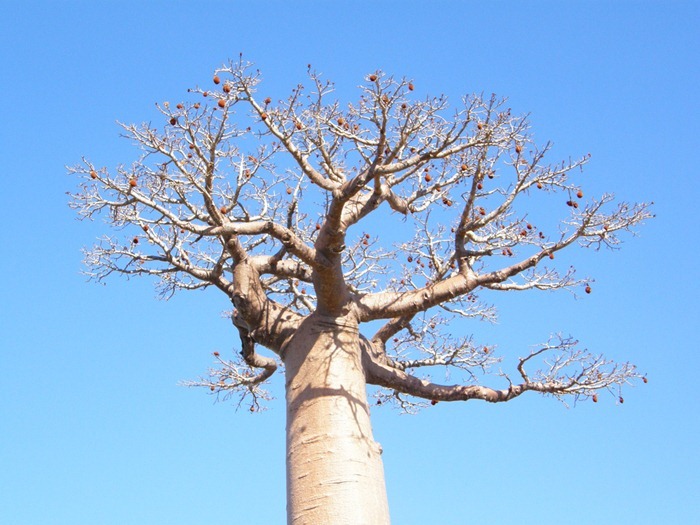Adansonia digitata, or Baobab tree is a strange looking tree that grows in low-lying areas in Africa and Australia. The Baobab is also called the upside-down tree because when bare of leaves, the spreading branches of the Baobab look like roots sticking up into the air, as if it had been planted upside-down. Legend holds that god Thora took a dislike to the Baobab growing in his garden, so he threw it out over the wall of Paradise on to Earth below, and although the tree landed upside-down it continued to grow. Another story goes that when the Baobab was planted by God, it kept walking, so God pulled it up and replanted it upside down to stop it moving.
The Baobab can grow to enormous sizes reaching heights of 5 to 30 meters and have trunk diameters of 7 to 11 meters. One African Baobab specimen in Limpopo Province, South Africa, is often considered the largest example alive. Up to recent times the tree had a circumference of 47 meters - its diameter is estimated at about 15.9 meters. Recently the tree split up into two parts and it is possible that the stoutest tree now is Sunland Baobab, also in South Africa with a diameter of 10.64 m and approximate circumference of 33.4 meters. Baobabs are also reputed to be many thousands of years old.
The baobab is highly regarded by African people because all of its parts can be utilized in some capacity. In addition to being an important source of timber, the trunks are often hollowed out by people who use them for shelter, grain storage or as water reservoirs. The hollowed trunks also serve as burial sites. Some of the most important products come from the bark of the tree, which contains a fiber that is used to make fishnets, cords, sacks and clothing. The bark can also be ground into a powder for flavoring food. The leaves of the baobab were traditionally used for leaven but are also used as a vegetable. Its fruits and seeds are also edible for humans and animals. The pulp of the fruit, when dried and mixed with water, makes a beverage that tastes similar to lemonade. The seeds, which taste like cream of tartar and are a valuable surce of vitamin C, were traditionally pounded into meal when other food was scarce. Other products such as soap, necklaces, glue, rubber, medicine and cloth can be produced from the various parts of the baobab tree.

The fruit of Baobab broke open.
Sources: Ohio State University, Wikipedia

















Comments
Post a Comment